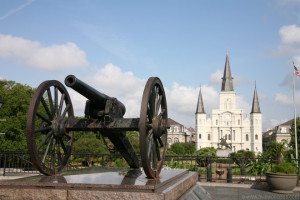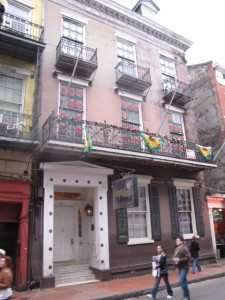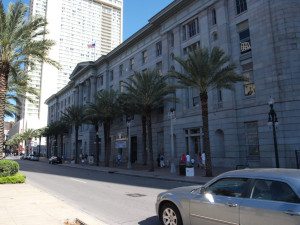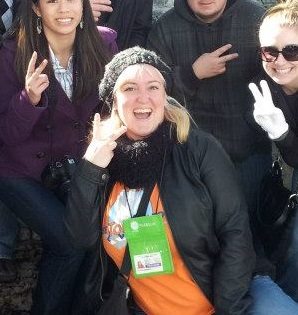Unlike the War of 1812, New Orleans did not see major fighting during the American Civil War. Yet, the city was the largest in the South.
It was a commercial, shipping, and manufacturing center without equal in Dixie. The Union coveted the city and sent major army and naval units to complete this task.
In April 1862, the city fell after the Union navy ran passed the guns at Fort Jackson and Fort St. Phillip.
The city was occupied for the rest of the war; only once did Confederate forces come close to recapturing it.
New Orleans has a variety of Civil War sites.
This Self-Guided New Orleans Civil War Tour will offer tourists in the French Quarter a look into the various buildings and dramatic moments that can be easily visited by anyone sticking to the Vieux Carre.
Be sure to take a look at our full selection of self-guided New Orleans tours.
A. Washington Artillery Park – Decatur Street Opposite Jackson Square

The outfit was founded in 1838 by the elite of Creole society. Many came to drill and practice in fine coaches, wearing posh clothes.
Still an active unit today, the artillery’s most famous service was during the Civil War, hence the choice of a Napoleon cannon to honor the unit’s history.
The Napoleon was the main cannon used by both sides in the war. The outfit was made up of five companies.
One through four fought in Virginia and Company Five in the western theater.
The men of this unit fought in nearly every major battle of the war, including Bull Run, Shiloh, Fredericksburg, Gettysburg, Chickamauga, Cold Harbor, and Atlanta to name only a few.
From here proceed down to the banks of the Mississippi River, which are just in front of you.
B. Mississippi River – Moon Walk
Today the river can be enjoyed on the Moon Walk, but back in 1862 the wharfs were full of ships and cargo.
Criminal gangs, such as the infamous Live Oak Boys, reigned supreme. It was at this point in the river that the Union navy approached the city.
Admiral Farragut’s steam-powered fleet ran the guns at Fort Jackson and Fort St. Phillip, putting New Orleans at the mercy of the Union warships.
The city was in utter chaos that night. Along the docks cotton was burned and stores were looted. Docks were burned freely.
Across the river at Algiers, workers fled from the ships they were constructing.
The most dramatic moment came when the powder magazine at Gretna, a city near Algiers, exploded in a terrific blast.
After that the incomplete CSS Mississippi, a mighty ironclad, sailed passed the fleet, on fire as the crew abandoned the ship but refused to surrender it to Farragut.
From here proceed left down the river front towards the French Market. At the end of the market you will find the Old US Mint.
C. Old US Mint – 400 Esplanade Avenue

As a prominent Federal building, it was here that Farragut’s marines first took down the Confederate flag and replaced it with the American one.
After this occurred William Mumford, a notorious gambler and womanizer, ripped down the US flag.
The mob then destroyed the banner. Mumford was later captured by Union troops led by Benjamin Butler, a fiercely patriotic man.
He decided to hang Mumford at the scene of his crime, a nod to the Spanish practice of executing criminals near the scene of their crime.
Mumford was executed despite the pleas of his wife. Today the mint is a museum and occasional Jazz venue.
Go left, and head down Esplanade
D. Louisiana Native Guards – Chartres and Esplanade
New Orleans had a large community of Free People of Color in 1861. They inhabited a gray area between that of slavery and the white community.
Their political rights were limited, but they had commercial rights and created a vibrant community.
The Confederacy was founded in part as a defense of slavery, yet many Free People saw military service as a means to show their loyalty and advance local causes.
Some 1,000 Free People of Color formed the first all black unit of the war, the Native Guards.
They were well dressed and trained, but the Confederates were not sure what to do with them. As such they were poorly armed and eventually disbanded.
The Confederates recalled the Native Guards in desperation and posted them along Esplanade Avenue, the city’s last line of defense, as Farragut’s fleet approached.
Here they stacked up boxes and awaited the Union army. The city was in chaos. Thousands of Confederate soldiers fled through the lines at Esplanade.
Many deserted altogether, destroying their uniforms and hoping to pass off as civilians.
The Native Guards held their position until the Confederates left but callously ordered the Native Guards to remain behind and resist the Union army.
This was an insult, as it would be a hopeless battle pitting 500 Native Guards against 18,000 Union soldiers.
After the city fell many Native Guards joined the Union army, making them the only unit in the war to serve both sides.
Proceed left down to the Beauregard-Keyes House
E. Beauregard-Keyes House – 1113 Chartres Street

It was also an important place in the life of Louisiana native Pierre Gustave Toutant Beauregard. In 1858 he lost an election for mayor of the city.
In 1860 he married Marguerite Caroline Deslondes, a member of one of the richest families in Louisiana, which increased Beauregard’s influence and would aid his future political career.
He spent his honeymoon in the Beauregard-Keyes House.
When the war came Beauregard became one of the South’s premiere generals, famous for firing the war’s first shots at Fort Sumter and winning the first major battle at Bull Run.
He paid a high price for joining the South. His wife died in 1864 and after the war he was penniless.
Right after the war Beauregard rented out a room and a cot in the Beauregard-Keyes House.
He did regain his status, designing the famous New Orleans streetcar grid.
He was also one of the few major Confederate figures to argue for equal civil and voting rights for the former slaves. In return he received many death threats.

F. Jackson Square – Jackson’s Statue
Originally dubbed the Place d'Armes, in 1856 a statue of Andrew Jackson was erected and the square renamed.
Butler’s troops, who occupied New Orleans, were subjected to many insults.
The most infamous action was when women would “accidently” dump their chamber pots on passing soldiers.
After Farragut was a victim of one socialite’s urine, Butler had many women arrested.
His General Order No. 28 decreed that women insulting Union soldiers would be treated as prostitutes.
He also had his men engrave the words “The Union must and shall be preserved” into the base of the Jackson statue.
This was a reference to Jackson’s famed warning to John C. Calhoun. Butler was happy to engrave the quotation since Jackson was one of his personal heroes.
Jackson Square was also the site of many Reconstruction scrapes. Although the Democrats and former Confederates won the fight over the city’s postwar future, they did not remove Butler’s 1862 engraving.
Approach the St. Louis Cathedral and enter Pirates Alley between the cathedral and the Cabildo. Head down Orleans Avenue and take a left at Dauphine Street.
G. Orleans Guard Battalion – 713 Dauphine Street
Among the colorful units from New Orleans, few were more flamboyant than the illustrious Orleans Guard Battalion.
It was made up of the city’s Creole elite. Beauregard was a private in the ranks, and although he left the unit, he still had a special love for it.
After Fort Sumter fell, he had the flagstaff from the fort presented to the Orleans Guard Battalion at this spot.
The men carried this flag into their first battle at Shiloh. They were also immaculately dressed in blue uniforms, which led to friendly fire incidents.
They eventually turned their bluecoats inside out to avoid such losses.
At Shiloh Beauregard grabbed the flagstaff of the battalion and led the unit in a charge that prevented the collapse of the Confederate Army.
Heavy losses led to the Orleans Guard Battalion being disbanded. Some members joined other Louisiana units, in particular the 30th Louisiana Infantry.
Proceed down Dauphine to Conti Street. Take a left, then a right onto Bourbon Street.

Before the war Benjamin was a successful New Orleans lawyer, living here from 1835-1845. In 1845 he bought a sugar plantation at Belle Chasse.
In 1846, while at his Bourbon Street home, his wife Natalie St. Martin, fled to France with their daughter.
Benjamin never divorced, and would go to Paris to see his daughter once a year.
Although a failure at love, he made a fortune in sugar and legal work. He became a Senator, then a member of the Confederate Cabinet, serving as Attorney General, Secretary of War, and lastly as Secretary of State.
He was Jefferson Davis’ main advisor. Wanted after the war for his part in terrorist plots, he fled to Britain and practiced law in London.
A controversial figure both then and now, his Bourbon Street home is today a strip club called Temptations.
A fine portrait of Benjamin is on display at the Historic New Orleans Collection at 533 Royal Street.
Proceed down to Canal Street, take a left, and continue until you reach the last stop.
I. US Custom House – 423 Canal Street

The building was used as weapons factory by the Confederates. Butler used it for the same purposes in 1862.
After the war it was the unofficial headquarters of the Republican Party.
It saw fighting during the Battle of Liberty Place, in which the White League defeated the integrated Metropolitan Police, led by the legendary James Longstreet.
The White League’s 1874 triumph was short lived, but the incident broke the back of the Republican Party. The Custom House remained a Republican stronghold until the presidency of Grover Cleveland.






